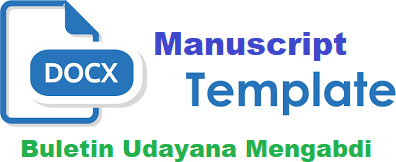DISEMINASI TEKNOLOGI PENGOLAHAN KOMPOS MENGGUNAKAN MIKROORGANISME LOKAL (MoL) DARI BAHAN ALAM SEBAGAI MEDIA DEKOMPOSER ALAMI
Abstract
The increase in the use of chemical fertilizers on agricultural land has occurred more rapidly since the green revolution era. The use of chemical fertilizers is increasingly worrying because it has a huge impact on the survival of living things. The use of organic fertilizers such as compost is an alternative that can be selected to reduce the use of chemical fertilizers. Compost is produced from a mixture of organic materials, both organic matter derived from livestock and organic matter from plants. The compost process technology needs to be disseminated to the community, especially farmers. This activity aims to increase the technological knowledge capacity of members of farmer/livestock groups in utilizing cattle feces waste. Technology dissemination activities were carried out at the “Balumbungan” Farmer/Livestock Group in Bontonompo Village, Bontonompo District, Gowa Regency. The application of local microorganisms (LoM) from natural materials (rice waste) as a decomposer has been applied in the process of making compost made from cow feces combined with laying hen feces. Rice waste contains carbohydrates which are a good source of energy for the survival of microorganisms. Utilization of LoM as a decomposer in the fermentation process of organic materials is an attempt to utilize natural materials that have been wasted so far. Rice waste is a good growth medium for bacteria and fungi that are important for plants. The final result of the activity is increasing partner capacity in utilizing fecal waste into compost.
Keywords: compost, dissemination, feces, decomposer, organic fertilizer
Downloads
References
Gazper, V. (1994), Metode Rancangan Percobaan. CV. Armico. Bandung.
He, X., L.Chen, L.Han, N.Liu, R.Cui, H.Yin and G.Huang. (2017), Evaluation of biochar powder on oxygen supply efficiency and global warming potential during mainstream large-scale aerobic composting in China, Bioresour. Technol. 245, pp.309-317.
Hubbe, M.A., M.Nazhad, and C.Sanchez. (2010), Composting as a way to convert cellulosic biomass and organic waste into high-value soil amendments: a review, Bioresources. 5(4), pp.2808-2854.
Lingga. (1991), Nutrisi Organik dari Hasil Fermentasi. Pupuk Buatan mengandung Nutrisi Tinggi. Yogyakarta.
Li, R., J.Wang, Z.Zhang, F.Shen, G.Zhang, R.Qin, X.Li, and R.Xiao (2012), Nutrient transformations during composting of swine manure with bentonite, Bioresour. Technol. 121, pp.362-368.
Mashur. (2001), Kajian Perbaikan Teknologi Budidaya Cacing Tanah Elsenia foetida Savigny untuk Meningkatkan Produksi Biomassa dan Kualitas Eksmecat dengan Memanfaatkan Limbah Organik sebagai Media. Disertasi. Program Pascasarjana Institut Pertanian Bogor, Bogor.
Murbandono. (1998), Pembuatan Kompos. Penebar Swadaya. Jakarta.
Proietti, P., A.Marchini, G.Gigliotti, L.Regni, L.Nasini, and R.Calisti. (2016), Composting optimization: Integrating cost analysis with the physical-chemical properties of materials to be composted, J. Clean Prod. 137, pp.1086-1099.
Supadma, A.A.N dan D.Arthagama. (2008), Uji formulasi kualitas pupuk kompos yang bersumber dari sampah organik dengan penambahan limbah ternah ayam, sapi, babi, dan tanaman pahitan, Jurnal Bumi Lestari. 8(2), pp.113-121.
Zhang, Q., J.Liu, H.Guo, E.Li, and Y.Yan. (2019), Characteristics and optimization of dairy manure composting for reuse as a dairy mattress in areas with large temperature differences. J. Clean. Prod. 232, pp.1053-1061

This work is licensed under a Creative Commons Attribution-ShareAlike 4.0 International License.

This work is licensed under a Creative Commons Attribution-ShareAlike 4.0 International License.




.png)


1.png) GARUDA - GARBA RUJUKAN DIGITAL
GARUDA - GARBA RUJUKAN DIGITAL



